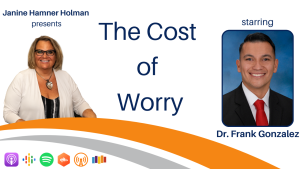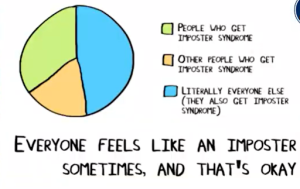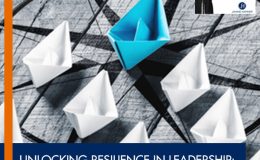
What’s your relationship with worry at home and in the workplace? Do you want to improve that relationship? In this episode, Janine Hamner Holman sits down with Dr. Frank Gonzalez, a self-described people enthusiast who is a leadership, and diversity, equity, and inclusion professional, to discuss the cost of worrying and how to combat it.
GUEST: Dr. Frank Gonzalez | LinkedIn, Instagram
HOST: Janine Hamner Holman | [email protected] | LinkedIn, Facebook, Instagram, and Twitter
What am I paying attention to today? I had a call with a client who was talking about helping her team prepare for annual reviews. Like most people, she doesn’t love giving nor getting annual reviews. She directly manages a team of about ten people who manage another 60 people.
Overall she has a large team and, over the last year, she, the CEO, has been working on being more of a coach and less of a manager. Certainly less of a micromanager.
She spent a lot of time over the last week, after getting back from the holidays, training her people to have productive conversations with their people. She went through a whole series of roleplays individually with each manager, helping them feel secure and ready to have these conversations that can be challenging.
She was telling me about how her manager, who has the most challenging team in the company, had their meetings with their direct reports and they all went really well and how proud she was of this leader.
I told her, “I’m proud of this leader and I’m really proud of you. I’m proud of how much you are getting out of the player-coach and into the coach mentality. That’s where you can help authentically support your people and get them ready for the challenges they are facing.”
Today’s guest, Dr. Frankie G, or as we know him, Frank, is a self-described people enthusiast who is a diversity, equity, and inclusion (DEI) and leadership professional. Frank has two decades of experience using evidence-based practices to solidify the qualitative experience of employees in various public and private corporation entities.
His focus on relationship-building models along with his facilitation background provides a unique perspective on experiential and practical applications. Frank holds a doctorate in philosophy in organizational leadership and management with an emphasis on personality and ingroup and outgroup relationships in the workplace, leader, and employee relationships as well.
His love of continuous enthusiastic learning is also the foundation of his DEI message: be curious. One of the ways I know Frank is as an inclusionist. I had never heard that word before meeting Frank and I love it. It’s such a great word. So Frank Gonzalez, welcome to the show.
Thank you, my friend. Happy New Year.
Can we revisit the intro? “I’m beginning to think,” if that doesn’t set the tone for creativity and curiosity, I don’t know what will. Thank you for inviting me and again, Happy New Year to you and everyone listening.
Happy New Year and I love it that you brought up the theme song. Our theme song was created by my cousin’s boyfriend, Keith. If you haven’t heard it yet, go back and listen to episode 50, Finding Your Voice with Julie Dean. Julie is my cousin and that is her and Keith singing while he is playing the guitar. I love that song! They created it for me so it makes me very happy,
Love it!
So, Frank, tell me what is something you have become aware of that people aren’t paying enough attention to, and what’s the cost of that?
I would say what we’re not paying attention to is the cost of worry.
When you think about worry and the cost it may have to your organization, or to you if you’re a leader and your direct reports… what cost that has to you, and what cost it has to the relationships you all have.
That’s definitely in the realm of inclusion because it’s a lot about you, it’s a lot about your environment. We’re environmental creatures. I’ll use an analogy for anybody who likes comics. Comics have been in the movies and it’s like vibranium. If you’re familiar with vibranium, it’s a fictional metal that has the ability to absorb energy, but it also has the ability to put that energy back out.
It’s the energy of worry we’re not paying attention to and there’s a huge cost to that. I’d love to dive into that. It was what you and I were talking about earlier, the environmental things that happen in our life that cause us to worry and may lead to some parts of our exclusion as well.

The very last part, it’s three layers, is “What lowers your worry?” You fill in the blank. “Walking lowers my worry when this happens.” “Talking with a friend lowers …” What lowers your worry when it comes to the organization, leader, yourself, and relationships with others. Before you can ever make that leap, regardless of race, ethnicity, gender, colorism, accessibility, or abilities. We can’t get into being included or belonging unless we have those.
One of the things I love that has happened with this focus on diversity, equity, inclusion, and belonging is the realization that wherever we meet another human being, we are coming into their movie. It’s been playing for however long and we don’t know what their background is.
We missed the first however many years, 20 years, 30 years, 40 years, 50 years of that movie. We’re coming in wherever we’re coming in and we only know what they feel safe to reveal to us.
As my listeners know, I always try to be honest, genuine and transparent. I got a phone call this morning from my mom letting me know that my dad, who turned 85 last September, is in the hospital with COVID-19. He had been diagnosed on Tuesday and last night around 11pm, he said to my mom, “We need to go to the hospital right now.” When they got in the car, he said to her, “You need to run all the red lights. This is an emergency.”
Right now he’s been admitted to the hospital, but he’s still in the emergency room. He’s not comfortable. He’s still on a gurney. Thinking about my beloved father in the hospital by himself with COVID-19, I could only talk to him for a couple of minutes because they just ran out of the house and he doesn’t have a cell phone charger.
An enormous amount of my brain space right now and probably all of my heart space is with my dad. They’re in Cambridge, Massachusetts. I am in Altadena, California.
I said to my mom, “Would you like me to come back home and be with you?” She said “No.” At any moment that may become necessary.
But I’ve made several work calls this morning. We’re here doing this podcast. I have another couple of meetings after this and it might not come up in those meetings. It’s a big part of what’s going on with me right now. If I were in a meeting and somebody said something that triggered me or made me think about my dad in a way that made me feel more worried or fearful, I could have a big reaction.
My emotions right now are very close to the surface. This conversation around our mental health, around us feeling like we are an integrated person, if I have things going on that I need or want to be able to share in a work context that have nothing to do with me as a worker, but have everything to do with me as a human, I think we’re still finding our way through navigating that. What are your thoughts on all of that?
Thank you for saying what’s on your mind and I’m sorry. Hopefully everything goes well. You said it, it’s also about being there for your mom. The other thing you said outside of the personal, that what’s going on is how it relates to work. Absolutely.
The analogy I have, you can do this in your mind or doodle something, whether you like bar graphs, Venn diagrams, or pie charts, about who you are personality-wise. This is going to get into inclusion and belonging. Who you are is about 60-65% (give or take) about who you are as a person.
The other piece when I was talking about being environmental is all those environmental reactions that might be temporary. Temporary to me might be six years, it might be six minutes for you.
Who we are when we talk about authenticity and servant-leadership, transformational, emotional intelligence, any model you subscribe to, it’s hard when that other 40% is going on. In the workplace, it’s hard to bring those things up when everything’s about deliverables and time.
When you think about worry, how does it affect things like creativity? Worry will not only hinder or bring to a halt or decrease relationships with yourself, with others, with your leader, and with your organization, it could also hinder other things like openness, creativity, your sense to put things in order, or to be a little bit warmer with others. If you’re focusing on other things to be a conflict manager, maybe part of your role is to manage the conflict of others. I’m already dealing with … as they say, my cup is full.
Everything you said is all research-based, but it’s also practical. We’re not paying attention to our worries. What can we do about that? The first thing is to vocalize it. Those are definitely barriers to being included and also feeling connections with belonging.
Part of the reason I try to be transparent, authentic and vulnerable in this podcast is to model that for other leaders. That’s part of what it takes to create an organization where that is accepted. If I have a team of a hundred people, 200 people, or 10,000 people who are part of my organization and I am never vulnerable, they are not going to feel safe being vulnerable. The more we can normalize it, the more we can say, “Yeah, s!*t happens in people’s lives.”
We want to pretend we’re functioning at 100%. It’s b@!!sh*t. I am not physically or mentally able to function at that level. I was talking with my mom and I said, “Dad’s still on this gurney and I think what would be really great is if you could bring some pillows and a phone charger to him at the hospital.”
Her response was, “Well what do I put that in?” I said, “We have those tote bags and you could put them in those.” She replied, “Okay, but they don’t zip.” I told her, “Mom, it’s pillows. It doesn’t matter if it doesn’t zip.” She asked, “Then how will I identify it?” I said, “You can take a sharpie and write on the outside.” She said, “Well what if they don’t let me bring it to him?” I responded, “Well mom, you could call the hospital.” She asked, “Well, what would I say?” and I said, “Mom, would you like me to call the hospital?”
I called the hospital, but this is her husband, they’ve been married for 61 years and he’s in a scary state and she didn’t sleep last night. Helping her think all of this through as a daughter but also as a leader in our family, that’s part of what we get to do with our people because we can get taken out by worry.
We get in a place where we can’t really think something through logically. My mom could not figure out how to get a phone charger and some pillows to my dad. My mom is an extremely smart woman. The worry and lack of sleep was completely inhibiting her ability to function.
Stepping in to support her in a way that lifts her up and holds her in this time. I also said, “Okay mom, if I’m not hopping on a plane, who of your friends are you reaching out to so you’ve got support around you during this time?” We continued our conversation, figuring out who she could get support from.
I am the eldest in our family so I am the first person she called to have a conversation about this. It’s not that different from an employee, a valued employee who is coming into work and seeming a little off.
How do we begin, Frank–from all of your research–to normalize that as an appropriate thing for a boss to check? “Hey Janine, you seem a little off and I want to check in. Is everything okay? How can I support you?”

You have woven in two main things and that’s where you need to start. Number one is that home life over here, those are natural reactions to what’s normalized at home.
Openness is highly correlated with inclusion and creative thinking, but you’re helping each other reduce that worry naturally. The other thing is what you said about it being no different than the workplace. It’s not, but it’s also not normalized in every workplace.
Our reactions or lack of reaction is because it’s unnatural. The human experience is unnatural. That’s why I started with the organization, and I’m talking about the highest leaders.
When we talk about diversity, representation and the act of inclusion, that’s why it starts there. If you want to really see where an organization is at, you talk about organizational culture and things like formulas, there are a lot of formulas.
Basically, the personality of your highest leaders, plus behaviors or minus behaviors, plus the values you put on the wall, or virtually, for those workforces is really indicative of your culture.
It starts with the organization. We always focus on managers; managers have the toughest job. You’re balancing the vision of the company and its priorities. You’re also managing actual people and their functions. It starts with organizations first.
Then leaders, then other people around you, and then you. How do you do that? I offer a simple solution: you have to vocalize it. Also, for those who are trying to normalize it for themselves, you have to start writing it down. A simple exercise I recommend is “my organization worries me when …” and write down a few things.
I love that! “My organization worries me when…”
It’s personalized, don’t worry about anybody else. That’s the thing about inclusion, it’s all about you. I could put some framework up: what expectations of that organization, what worries you? Then layer it down.
“My leader worries me when,” “Others worry me when,” “I worry me when.” Not a long list. Normalize it for yourself so you understand what your expectations are and what drives worry so you can help reduce it and bring those things to yourself.
The second thing is “When my organization worries,” and then again the same thing. What are the worries? When they worry, it’s getting to an action:
- Go for a walk
- Yell
- Alcohol consumption
… and other temporary fixes that are supposed to make us feel good, not better. Think about that: good, not better. Have a good time. The coping is going to be temporary.
The very last part– it’s three layers–is “What lowers your worry?” You fill in the blank. “Walking lowers my worry when this happens.” “Talking with a friend lowers …” What lowers your worry when it comes to the organization, leader, yourself, and relationships with others. Before you can ever make that leap, regardless of race, ethnicity, gender, colorism, accessibility, or abilities.
We can’t get into being included or belonging unless we have those.
In my specific research, I’ll end here. My specific research focuses on different areas talking about the ingroup, outgroup, and relationship. It’s built off the multidimensional measure (MDM), leader-membership exchange (LMX) for those who are familiar. That’s a relationship between leader and member.
It’s the realization that we are treated differently because we are different. What we do about that and what the layers of relationship progress or regression we have that take place. In professional respect, that’s who you are, your credentials, and your contributions.
I have surveyed several hundred full-time employees who mirrored the demographics of our labor force. It’s a great study. When you worry, that lowers the professional respect you have in your mind.
When I say worry, I’m also talking about constantly seeking approval and second-guessing yourself. You start to worry so much and you second-guess everything. It’s like losing your keys and they were right in front of you the entire time.
It’s professional respect, who you are, and your work contribution, lowers that. The other part is the contribution, the residual effort you put in. So you’re trucking along, then the whole day went by, you might have put in 11 hours and nobody asked you to do that.
You’re so caught up in your work and you love it and you feel like people see that, you resonate and you’re just in a good mood. But this is still transactional. These two layers are transactional, worry reduces your feelings that contribution is really being received.
The other two higher layers of you getting included and getting that exposure, mobility, accessibility, and being included or having that connection, these are higher layers. Loyalty is also an effect you hear a lot about in research.
In those two higher levels, worry also significantly reduces your ability to really feel like the loyalty with a coworker or boss is there.
I’ll talk about loyalty, and this is where inclusion really is. Loyalty is about, what would you feel your manager or your organization would say about you when you’re not in the room? When you’re not in the room, if I gave you a scale of one to five–five for sure, Janine would be talking praises about me, whether I’m in the room or not.
That’s what gets me the exposure to be included in those meetings, to get mobilized into pockets where I’m not represented. If I worry so much, I’m really going to be marking lower numbers. There’s room for improvement and it starts with me. I know I gave you a lot there, but that’s years of research in five minutes. Did I do all right?
You were brilliant, Frank.

I found this graphic and I love it. Imposter syndrome is the feeling we get when we feel like, “Oh man, they are going to figure out that I don’t know everything or that I don’t know as much as I pretend I do or I really don’t belong in this room, in this conversation.” We all at some point have this feeling. I loved this pie chart. People who get imposter syndrome are this amount of people, then other people who get imposter syndrome are this amount of people literally everybody else because they get imposter syndrome too.
There’s a direct connection between imposter syndrome and feeling like we belong. I wanted to put this out to you to expound upon this idea around imposter syndrome and its connection to DEI.
First, I love the graphic, not just because of what the content is, but because it’s perfectly imperfect. It’s the concept there. Isn’t perfectionism part of worry too? What are people going to say and how you show up, things like that. When I say that worry and how that is, I want people to understand, it’s almost like Einstein’s “The Acquiring of Knowledge.”
You feel even less knowledgeable because now you’re down this deep oasis of the unknown and you realize, “Am I the only one that sees this? There’s so much more to explore?” Education, although great, people at all levels of education feel that.
Even when I’ve done my own research again with several hundred professionals, I feel that sense of “Do I belong here?” There’s always somebody better or more knowledgeable. How do you combat that? That’s education and then the pay. If you’ve ever said, “I want to make X amount of money.”
Once you get there, if you’ve never experienced it before, you ask yourself, “Do I deserve this kind of money?” The first couple of times you’re all excited, you’re not worried.
Then it normalizes and the imposter syndrome comes up. It’s still a feeling of “Do I deserve this kind of pay?” When you’re interviewing, that can come across sometimes if you’re looking for new opportunities. They see you at a certain title, a certain role, a certain pay, and let’s say you’re looking for something that makes you happy and you’re willing to go down from whatever level to this level.
They will actually scope beyond and say, “Are you sure?” You ask yourself, “Am I sure?” That correlation, it’s beyond gender, race, and ethnicity. Those are still factors. One thing I didn’t mention in my research is that race and ethnicity are always significant in those four levels.
It’s an added layer, but worry comes first and that starts with you. What do you do to combat that? Simple things are normalizing it once again and saying, “You know what? Worry is not that bad.” It means you’re human. Can we just humanize things for a little bit. It’s okay to be a little bit worried.
Yeah, it’s totally okay. It’s human.
A little worry is okay. I’m saying when it actually paralyzes you in thought, what do you do? Vocalize it, write it down, then take action, those three steps to figure out what works for you. I can give you advice all day long. That’s not going to stick.
For adult learning, I’m getting you to think. What you do is up to you. But I am giving you steps on what to do. Vocalize it, write it down, and find what works for you. Understand that it’s completely normal to worry, imposter syndrome will always be there. The more money you make, the higher titles you get, and the more exposure. That imposter syndrome is big.
You know firsthand with some of the clients who say, “I am the fill-in-the-blank title. I don’t know if I’m a great leader.” You’re questioning that. “What do your engagement scores say? What does this say? That doesn’t matter right now. I’m paralyzed in thought. I don’t know what to do in life. “
I have this conversation with CEOs, surgeons, people who, when we think of the top of the mountain, that’s where these people are and they have it too. It’s back to normalizing that.
I also find for myself, Frank, and I wonder what your thoughts are about this. There are some things I find helpful in some situations in calming me down. There are other things in other situations I find helpful.
Then there are a few, no matter what’s going on, a hug from my husband, that’s always going to make me feel better no matter what is going on. Being at the beach. It’s always going to make me feel better.

For some of us, it is specific songs, it’s specific sounds. For some of us, it’s running. For some of us, it’s reading a book. For some of us, it’s playing a game on our phone or our computer or something that gets us out of our head.
For some of us, it’s getting into action about whatever that thing is that worries us. Is it typical that there are some things that are really helpful in specific situations and other things that are helpful in other kinds of situations?
Absolutely. For those who are listening, I encourage you to look into the cognitive bias codex. Keep what resonates with you.
What’s worrying is making decisions about my career, about my family, dealing with personal work, and this worry. How do you bring that down? You’re going to consistently have to do that. Who you are right here, this could be broken down, that wall of worry, it could be chiseled.
The cognitive bias code, it’s in four categories.
What Should We Remember?
You’re talking about memory. Some songs, conversations, and experiences, bring up a memory. Whatever helps calm that. Memory is huge.
Not Enough Meaning
This is the land of ambiguity. Are you worried about a situation you’ve never been in? That’s where usually a conversation with someone else you feel has more experience than you, a mentorship and guidance and sponsorship helps. “How do I navigate ambiguous situations I’ve never been in?” That can create worry and that can actually halt your decisions and who you are.
Too Much Information
Then there is information overload. I just don’t know what I’m looking at.
Hospital forms for your father, unfortunately much less ambiguous and more an information overload. A slide deck I’ve been given by my leader or my organization. It’s worrying me because I don’t know what I’m looking at. I’m going to have to Google the Google stuff.
Need To Act Fast
The last piece is speed, that speed of information. That’s where the real bias starts to come in. I give up on these other things critically and it happens within a split second or seconds.
Then all of a sudden I’m relying on intuition. Again, it’s still being halted and you’re going to revert back to prior experiences. When you think about leadership in general, going back to overarching leadership, it’s the Greek philosophy of “Great leaders learn from every experience and person. Mediocre leaders rely on experiences. Horrible leaders have all the answers.”
I’ll go back to, “It’s okay, you normalize it.” Memory, ambiguity, information overload, and speed are part of all our worry and decision-making. How do you overcome that? Vocalize it, normalize it, it’s okay. Seek conversations with others. That always helps.
That’s the belonging, the connection, being able to connect with others. I think about collaborative work environments and about inclusion. I think about the contributions I have made, loyalty, my boss speaking highly of me, and including me in decisions in the organization. All of that is what creates belonging and connection.
What’s the connection you need to lower your worry and make the great things about yourself and others really flourish?
I often encourage people to take five minutes at the start of every meeting, or at the end of every meeting to check in. I believe it was Microsoft or one of the big tech companies that made it a standard during the pinnacle of COVID-19, “Before we start the meeting, how’s everyone doing?”
You could do it. Team meetings. “In the last five minutes, we’re going to save time for chatting. How’s everybody doing?” Those are things you can incorporate. People need that. If you’re going to be a great leader, do that. If you’re going to be a great follower in how you accept influence, expect that. “I need time to tell you, I have stuff going on at home right now and it’s preventing me from being my best self.”
Your manager, your leader, they want to know that information because it’s going to help them support you better in getting the things done that need to be done.
There may be some time-critical things that need to get shuffled around because you are not able to be your best right now. We fall into this, it’s not really a syndrome, but it’s sort of a syndrome of feeling like “I need to have it all together all the time.”
The reality is nobody has got it together all the time. None of us.
I’m pointing to myself and saying, “Nope, I know I don’t have it together.” I’m vocalizing it though. What do I need to do to get it together right now?
“So I don’t have it all together. What do I need to do to be able to function as best as I can at the moment? Then what do I need to do to get back to being able to fully function?”
It may be that some circumstances need to change. My dad needs to get out of the damn hospital, that will help. But I don’t want him out of the hospital until he’s been helped and healed. He’s coughing up a storm right now. I want him to get the treatment he needs and then to be able to go home and be with my mom.
Until that happens, I will not be fully functioning. Then what do I need to support me given the circumstances I’m operating in?
The reality is, this is what is happening with me right now on the two-year anniversary of the insurrection of January 6th. Other people may be having reactions to the fact that it’s the two-year anniversary of January 6th. Other people may be having reactions to whatever’s going on in their own lives. As we’ve been talking about, figuring out how to normalize those things, I think that is where the game is at.
Think about all this. It comes before you can start to have those expectations of the organization, your leaders, or others.
That is part of that “know thy self.”
Well, what worries you? We’re not paying attention to worry, but a worry, again, significantly reduces so many other factors of who you are. We’re talking about authenticity, there are several other people you have to work with and react to in that authentic environment.
Authentically, I love to curse all the time. I’m not sure if every other word out of my mouth is a curse word. If that’s my authentic self, and I’ve met people like that and that’s just who they are, and you get to know me, you might think, “That’s actually kind of charming.”
Every time, maybe with new people, it becomes a normalized thing. I might say, “Hey, no worries, I just curse a lot. I’m sorry, let me know when I do it too much.”
That’s one of those things to decide as an organization: the policy around swearing. I have a policy around swearing on the show, which is that I swear for accuracy, not for impact. If it’s going to be “She said a bad word!” I never swear for that reason. Today I said it’s b$lls!*t because whatever it was, was in fact b@!!sh#t.

Some people have language laced with profanity and it’s the way that they talk. Then the organization has to decide. Our last episode was about this idea of “Do we really want people to bring their whole selves to work? What does that really mean?”
If part of how you as an organization need to present is that people don’t swear, then that part of that person just doesn’t get to be expressed at work. There are all kinds of parts of us that don’t get to be expressed at work.
We’re at this place where it’s important to get very conscious about what we mean when we talk about “bringing your whole self to work” and how we have people be able to be authentic and genuine and be able to feel included. We also have to be really clear about “My rights end where your rights begin.”
It may be that I have certain beliefs that are not appreciated here in this organization, and that just gets to be a part of me that does not get expressed at work. We as an organization need to set the norms so people are really clear about it and it gets to be consistent throughout the organization. It doesn’t work if, “Well, Frank gets to swear, but Janine doesn’t get to swear.” Nope. That’s not how it works.
Well, Frank, this has been such a delight and there have been a couple of times when I’ve looked at the clock and I’ve thought, “Oh man, we’ve been trying to have this be a 30-minute show, and we’ve been trying to have more graphics and visual things.”
I love and adore you so much that I got totally caught up in this conversation. When you and I were first talking about this, we said, all right, the Frank and Janine show is going to be called Laughter and Tears.
There will be a Frank and Janine show, part two, more laughter and tears to come your way. Frank, it has been a delight. I adore you and I adore what you’re up to, creating both for your organization and for the world. Thank you so much for sharing yourself with us today.
Thank you.
You’re more than welcome. I am Janine Hamner Holman, and this has been The Cost of Not Paying Attention. Remember, great leaders make great teams. Until next time.
Important Links
Diversity, Equity, and Inclusion (DEI)
About Frank Gonzalez
Dr. Frank has been working in the DEI space to help businesses build better teams with strong communication since 2010. A self-described people enthusiast, his goal is to build relationships and help people find fulfillment in work and life.
Dr. Frank has a BA in sociology from the University of Texas at Austin, an MS in organizational leadership, as well as a Ph.D. in organizational leadership and management from Our Lady of the Lake University.
As a diversity, equity, and inclusion (DEI) and leadership professional, Frank has two decades of experience using evidence-based practices to solidify the qualitative experience of employees in various public and private corporation entities.
Frank’s focus on relationship-building models along with his facilitation background provides a unique perspective on experiential and practical applications. He holds a doctorate in philosophy in organizational leadership and management with an emphasis on personality and ingroup and outgroup relationships in the workplace, leader, and employee relationships as well.
His passion for ongoing enthusiastic learning has been the basis of his DEI message of “be curious.” Frank has a curiosity for life, people, and relationships that drives him forward in his career and personal endeavors.
Dr. Frank is, first and foremost, an inclusionist. He is inspired by people and his inspiration plays into his goal of helping businesses and individuals be included and learn how to include others.






